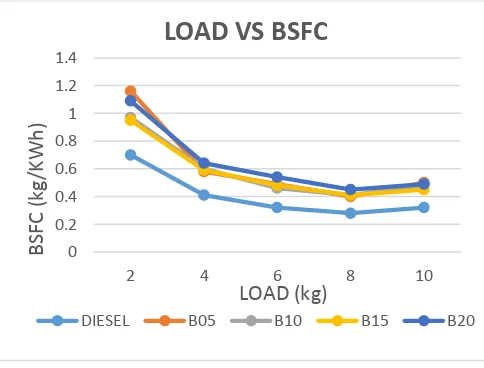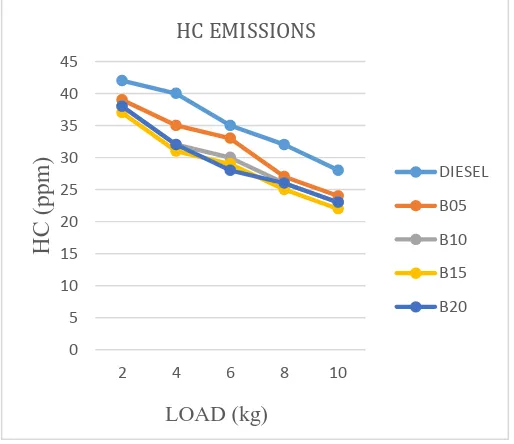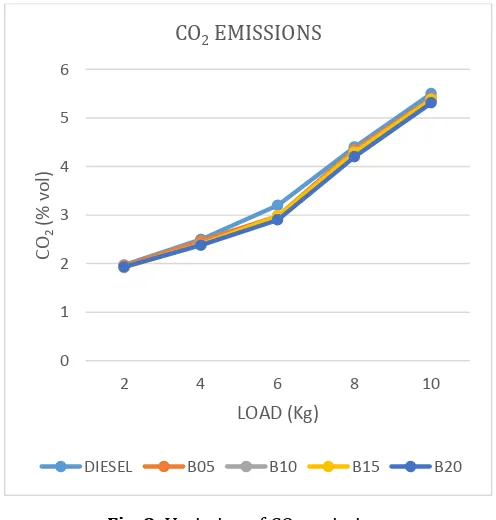International Research Journal of Engineering and Technology (IRJET) e-ISSN: 2395-0056
Volume: 06 Issue: 07 | July 2019 www.irjet.net p-ISSN: 2395-0072© 2019, IRJET | Impact Factor value: 7.211 | ISO 9001:2008 Certified Journal
| Page 2846
EXPERIMENTAL INVESTIGATION ON PERFORMANCE OF DIESEL ENGINE
ON MIXING OF TWO BIODIESELS BLENDED WITH DIESEL
N. SREENIDHI¹, Dr. B. CHANDRA MOHAN REDDY²
¹PG Scholar, Dept. of Mechanical Engineering, JNTUACEA, Ananthapuram, A.P., India.
²Associate professor of Mechanical Engineering, JNTUA, Ananthapuram, Andhra Pradesh, India
---***---Abstract - Quick automation and evolution in population and industrialization had resulted in the rapid growth of energy demand. Undiscriminating usage of fossil fuels led to the extermination of petroleum resources. Pollutant emanations from diesel engine have triggered foremost effects in troubling the environmental system by the release of harmful emissions and causing global warming. To daze these complications, we focused on the alternative sources like biodiesels which are derived from vegetable oils, animal fats and algae. Greater viscosity is the major problem in the usage of vegetable oils directly in a diesel engine that can be detached by transforming it into biodiesel by Transesterification. The present work is focused on the amalgamation of two biodiesel blends with diesel that are Jatropha and Mustard oil that are mixed in equal proportions on volume basis (5%, 10%, 15%, 20%). The investigational tests are done in an unmodified diesel engine and the optimum blends are found for the engine better performance.
Key Words: Dual biodiesel, Jatropha Curcas, Mustard oil performance characteristics, emission characteristics
1. INTRODUCTION:
Consumption of petroleum-based fuels that are obtained from inadequate reserves has been mounting because of the rapid industrial development and motorization of the world. This also primes to the climatic variation and results in global warming. This directed to the practice of biodiesel which is a substitute fuel identical to conventional or fossil fuel. Biodiesels can produce from plant oils, animal fats, algae, waste cooking oils etc. Biodiesel is non-hazardous and eco-friendly, oxygenated, Sulfur-free, renewable and sustainble. The biodiesel can consume purely or it can also blended with diesel and used in an engine with or without any modification required. Vegetable oils which are used in biodiesel production have similar heat values as that of pure diesel. The main disadvantage in using the biodiesel is its higher viscosity which can be degraded by preheating the oils, transesterification process or blending with diesel. Competed to petroleum diesel fuel, which is purified from natural oil, smaller amount of air contaminants such as particulates, carbon monoxide, Sulphur dioxide, unburnt hydrocarbons, and air toxics can be emitted from biodiesel. Nitrogen oxides emissions from the combustion of biodiesels are slightly higher than the emissions from that of diesel fuels.
2. LITERATURE REVIEW:
Venkateshwara Rao P used Pongamia pinata and Jatropha oils mixture which are blended with diesel fuel at a variety of proportions conducted experiments in Kirloskar diesel engine and determined that biodiesels can used as fuels for stationary diesel engines for the persistence of agriculture.
K. Srithara et al. had done experiments in a diesel engine on dual biodiesels and its blends. The biodiesels used were Pongamia pinnata and mustard oils. The experiment outcomes concluded that the thermal efficiency and mechanical efficiency were somewhat higher than the diesel and the fuel consumption values of dual biodiesels were similar to that of diesel values.
Puneet Varma and M.P. Sharma had given conclusion that analysis of performance parameters like BSFC, BTE reduces as the blend ratio of biodiesel with diesel increased, decrease in HC and CO emissions and increase in Nitrogen oxides emissions with the biodiesels.
Pankaj Dubey and Rajesh Gupta on conducting experiments on Kirloskar engine with dual biodiesels Jatropha and Turpentine oil and narrated that BSFC was higher and BTE was lower as compared to that of conventional diesel engine.
Rahimi conducted experiments on diesel engine by using Diesterol (mixture of diesel, bio-ethanol, and sun-flower methyl ester) and concluded that as the percentage of bio-ethanol in the blends increases, the percentage of CO concentration in the emission reduces. This is because of the reason that bioethanol has a lesser amount of carbon compared to diesel.
International Research Journal of Engineering and Technology (IRJET) e-ISSN: 2395-0056
Volume: 06 Issue: 07 | July 2019 www.irjet.net p-ISSN: 2395-0072© 2019, IRJET | Impact Factor value: 7.211 | ISO 9001:2008 Certified Journal
| Page 2847
seed oil, canola oil etc. The present work conveys an experiment of combination of two biodiesels Jatropha Curcas and Mustard oil that are blended with diesel fuel. In the first step the physical and chemical properties of the two biodiesels are found and examined that the chemical properties are almost near to the diesel fuel. In the second step of experimentation the performance and exhaust emission characteristics of a diesel engine with dual biodiesel and its blends and the results are competed and the optimum blend is found for the engine performance.
3. MATERIALS AND METHODS:
The dual biodiesels (jatropha Curcas and mustard oils) used in this experimentation are prepared by the transesterification process. The biodiesel blends were made in different proportions as B05 (diesel-95%, jatropha and mustard oil-5% with equal proportions), B10(diesel-90%, jatropha-5%, mustard oil-5%) on volume basis, B15(diesel-85%, jatropha-7.5%, mustard-7.5%), B20(diesel-80%, jatropha-10%, mustard-10%) on volume basis, B100(100% pure diesel). The several chemical and physical properties of pure oils and different blends like kinematic viscosity, density, dynamic viscosity, specific gravity, flash point, fire point, calorific value, cetane number were obtained by using ASTM methods and are competed with that of diesel fuel properties. The experimental works were performed on a single cylinder four stroke water cooled VCR diesel engine with electrical loading and performnce and emision characteristics were competed with that of diesel fuel. The properties of fuels are as shown in table 1.
Table-1: Properties of fuels and blends
4. EXPERIMENTAL SETUP:
The engine setup for experimentation is Kirloskar make for loading with computer interface with all required instrumentation. The specifications of the engine are as shown in the Table-2. The present research experiments are carried out on a single cylinder 4 stroke water cooled diesel engine using different proportions of dual biodiesel blends at variable loads and at constant speed of about 1500 rpm. The emission test was carried out by using AVL DIGAS-444 five gas analyzer and the optimum blend of biodiesel is found for the best engine performance about 1500 rpm. The emission test was carried out by using AVL DIGAS-444 five gas analyzer and the optimum blend of biodiesel is found for the best engine performance.
Table-2: Engine Specifications
S. No Type Specifications
1 Make Kirloskar
2 Engine Single cylinder, four stroke, water cooled VCR diesel engine CR ranging from 12 to
18
3 Bore diameter 87.5mm
4 Orifice diameter 20mm
5 Stroke length 110mm
6 Compression
ratio 17.50:1
7 Constant speed 1500rpm
8 Injection pressure 200 bar
S. No Properties Diesel Jatropha Mustard Blend B05 Blend B10 Blend B15 Blend B20 1 Kinematic
viscosity×10‾⁴ (m²/s)
2.3 3.3 3.6 2.8 3.1 3.2 3.6
2 Density (kg/m³) 830 925 920 830 845.6 846.8 847.2 3 Dynamic
viscosity×10‾⁴(m ²/s)
1.84 2.76 3.62 1.84 2.56 2.6 2.65
International Research Journal of Engineering and Technology (IRJET) e-ISSN: 2395-0056
Volume: 06 Issue: 07 | July 2019 www.irjet.net p-ISSN: 2395-0072© 2019, IRJET | Impact Factor value: 7.211 | ISO 9001:2008 Certified Journal
| Page 2848
5. RESULTS AND DISCUSSIONS:5.1 Performance Characteristics:
5.1.1. BRAKE THERMAL EFFICIENCY:
[image:3.595.180.414.225.420.2]Fig 2: comparison of brake thermal efficiency for different blends
Fig. 2 illustrates the deviation of brake thermal efficiency with load at constant speed for various blends and diesel. It is proven that the brake thermal efficiency increases with increase in load and it is low for the different blends than diesel. It is examined that blend B15 is close to that of diesel.
5.1.2. SPECIFIC FUEL CONSUMPTION:
Fig 3 depicts the variation of brake specific fuel consumption with load for different dual biodiesel blends and diesel. It is clearly seen that brake specific fuel consumption decreased with rise in load and then slightly increased with increase in load at constant speed.
Fig 3: comparison of brake specific fuel consumption with load for different blends.
0 0.2 0.4 0.6 0.8 1 1.2 1.4
2 4 6 8 10
BS
FC (kg/
KW
h
)
LOAD (kg)
LOAD VS BSFC
DIESEL B05 B10 B15 B20
5 Flash point (℃) 56 49 51 47 48 49 49
6 Fire point (℃) 63 51 52 48 49 50 51
7 Calorific value
(MJ/kg) 45.5 39.43 37.43 44.8 42.1 42.9 43.3
[image:3.595.176.418.558.742.2]International Research Journal of Engineering and Technology (IRJET) e-ISSN: 2395-0056
Volume: 06 Issue: 07 | July 2019 www.irjet.net p-ISSN: 2395-0072© 2019, IRJET | Impact Factor value: 7.211 | ISO 9001:2008 Certified Journal
| Page 2849
5.2 EMISSION CHARACTERISTICS: [image:4.595.172.420.156.354.2]5.2.1. CO EMISSIONS:
Fig 4 depicts that the CO emissions are lower for dual blends than diesel because of having more oxygen which helps in the complete combustion of fuels.
Fig.4: Variation of CO emissions 5.2.2. HCEMISSIONS:
Fig.5 depicts the variation of HC emissions with load and it is observed that diesel has higher HC emissions than the biodiesel blends as biodiesels has more oxygen which helps in the complete combustion of the fuels. In the fig it is clearly seen that blend B15 has lower HC emissions than other blends.
Fig 5: variation of HC emissions 5.2.3. NOx EMISSIONS:
It is shown that diesel emits lesser NOx emissions than the dual biodiesel because diesel has less oxygen and the NOx
emissions are directly proportional to the exhaust temperature which increases with load. In fig 6 it is seen that NOx
emission is higher for blend B15 at maximum load and diesel has lower NOx emissions.
0 0.02 0.04 0.06 0.08 0.1
2 4 6 8 10
C0
(%
v
o
l)
LOAD (Kg)
CO EMISSIONS
DIESEL B05 B10 B15 B20
0 5 10 15 20 25 30 35 40 45
2 4 6 8 10
HC (ppm)
LOAD (kg)
HC EMISSIONS
DIESEL
B05
B10
B15
[image:4.595.170.427.444.666.2]International Research Journal of Engineering and Technology (IRJET) e-ISSN: 2395-0056
Volume: 06 Issue: 07 | July 2019 www.irjet.net p-ISSN: 2395-0072© 2019, IRJET | Impact Factor value: 7.211 | ISO 9001:2008 Certified Journal
| Page 2850
Fig 7: variation of NOx emissions [image:5.595.166.420.76.288.2]5.2.4. CO2 EMISSIONS:
Fig. 8: Variation of CO2 emissions
From the fig 8 it is depicted that CO2 emissions decreases for dual biodiesel blends than the diesel fuel. The reason is having higher oxygen content in biodiesel blends than the diesel fuel.
6. CONCLUSIONS
From the experimental investigations following are the conclusions that can be drawn:
1. The brake thermal efficiency of blend B15 is close to that of diesel at all loads. At maximum load the brake thermal efficiency of all the blends is very close to that of diesel.
2. The BSFC of diesel and all the dual biodiesel blends first decreases up to 8kgs of load and then increases with load at constant speed. The BSFC of B15 is slightly higher than that of diesel.
3. The CO and HC emissions of the diesel are higher than that of the dual biodiesel blends as they have more oxygen content which helps in the complete combustion of the fuels.
4. The NOX emissions of dual biodiesel blends are higher than the diesel fuel.
0 100 200 300 400 500 600 700
2 4 6 8 10
NO
x
(ppm
)
LOAD (kg)
NO
XEmissions
DIESEL
B05
B10
B15
B20
0 1 2 3 4 5 6
2 4 6 8 10
CO
2
(%
v
o
l)
LOAD (Kg)
CO
2EMISSIONS
[image:5.595.173.421.329.589.2]International Research Journal of Engineering and Technology (IRJET) e-ISSN: 2395-0056
Volume: 06 Issue: 07 | July 2019 www.irjet.net p-ISSN: 2395-0072© 2019, IRJET | Impact Factor value: 7.211 | ISO 9001:2008 Certified Journal
| Page 2851
Based on the experimental investigations the dual biodiesel blends give less emissions of CO and HC and better performance with that of diesel.
NOMENCLATURE:
Symbol Abbreviations
rpm Rotations Per Minute
ppm Parts Per Million
CO Carbon Monoxide
HC Hydrocarbons
NOx Oxides of Nitrogen
CO2 Carbon dioxide
BSFC Brake Specific Fuel
Consumption
ACKNOWLEDGEMENT:
I would like to show my special thanks of gratitude to my guide Dr. B. Chandra Mohan Reddy, Associate Professor, Head of Mechanical Department for his pearls of wisdom in guidance and support for the project.
REFERENCES:
1. H. Rahimi, B. Ghobadian, T. Yusuf et al., “Diesterol: an environment-friendly IC engine fuel”, Renew. Energy, vol. 34, pp.335-342, 2009.
2. Avinash Kumar Aggarwal, K. Raja Manoharan. “Experimental investigations on the performnce and emisions of Karanja oil and it’s blends in a single cylinder agricultural diesel engine”. [J] Applied Energy, 2009.86: 106-112. 3. Forson FK. Oduro and Hammond-Donkoh E. (2004). “Performance of Jatropha oil blends in a diesel engine”.
Renewable Energy. 29. pp. 1135–1145.
4. Pramanik K (2003). “Properties and use of Jatropha oil and diesel fuel blends in C.I. engine”. Renew. Energy. Vol. 28, Issue No. 2, pp. 239–248.
5. Y. Sinuka, I. Omar, S. Mokhama (2012). “Performance testing of a diesel engine runing on varing blends of Jatropha oil, waste cooking oil and diesel fuel”.
6. Ekanath R. Deore, Milind S. Patil, Ramachandra S. Jahagirdar (2014). Effect of blend of two kinds of biodiesel on performnce and emision of single cylinder DI diesel engine.
7. T. Mrinalini, R. Anand and N. V. Mahalakshmi, 'Jatropa Oil as a Renew. Fuel in DI Diesel Engine', Proceedings of the 3rd BSME-ASME International Conference on Thermal Engineering, 2006. [3]
8. K. Mostafijr Rahman, Mohammad Masud, Md. Roknuzzaman and Asadullah Al Galib, 'Biodiesel frm Jatropha Oil as Altrnative Fuel for Diesel Engine', International Journal of 510 Mechanical & Mechatronics IJMME-IJENS, 2008, Vol. 10, Issue No. 03.
9. Monjurl Hasan, Ahmed, M. S, & Muhaimnul Hasan, A. S. M. (2013). Experiment for produng a renewable alternative fuel for Bangladesh from mustard oil. 2013 2nd International Conference on Advances in Electrical Engineering (ICAEE).
10. L. M. Das and P. K. Saho "Combution analsis of Jatropha, Karanja and Polanga based biodiesel as fuel in a diesel engine" Fuel, vo1.88, pp.994-999, [2009].
11. G. Prabakar Rao and K. Hema Chandra Reddy T. Venkateshwara Rao, "Experimntal investigation of pongami, jatropha and neem methyl esters as biodiesel on C.I. Engine"," Jordan journal of mechanical and industrial engineering, vol. 2, pp. 117-122, June, [ 2008].
BIOGRAPHIES:
N. SREENIDHI
International Research Journal of Engineering and Technology (IRJET) e-ISSN: 2395-0056
Volume: 06 Issue: 07 | July 2019 www.irjet.net p-ISSN: 2395-0072© 2019, IRJET | Impact Factor value: 7.211 | ISO 9001:2008 Certified Journal
| Page 2852
Dr. B. Chandra Mohan Reddy M. Tech, Ph.D.,
Head of Mechanical Department, JNTUACEA, Ananthapuram, A.P., India Number of Research Publications: International Journals: 25


